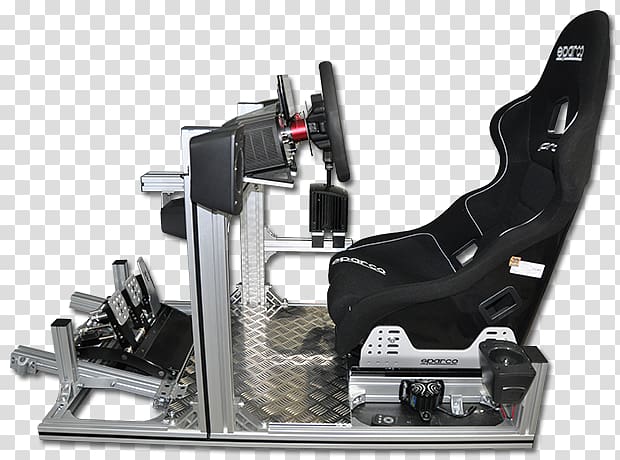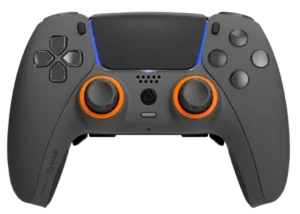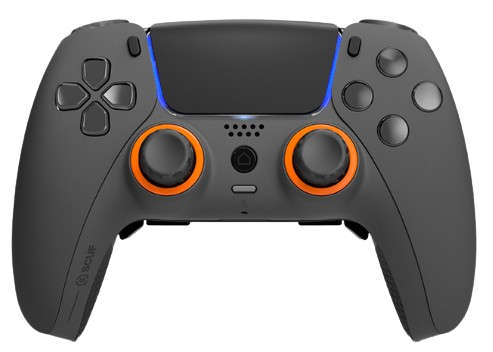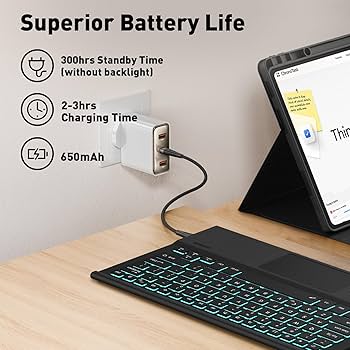The roar of an engine, the screech of tires on asphalt, the subtle feedback of the road surface through your hands—these are the sensations that define motorsport. For decades, video games have strived to capture this thrill, but a standard gamepad can only go so far. It translates the complex physics of a high-performance vehicle into simple vibrations and analog stick movements. For those who crave true immersion and a competitive edge, the solution lies in a dedicated piece of gaming hardware: the racing wheel. This is not merely a controller; it’s a gateway to a deeper, more authentic connection with the virtual car and track.
The world of racing wheels has evolved dramatically from the simple, spring-loaded peripherals of the retro gaming era. Today’s market offers a vast spectrum of technology, from affordable entry-level models to professional-grade direct drive systems that replicate the forces of a real race car with astonishing accuracy. This article serves as a comprehensive technical guide for anyone looking to enter the world of sim racing or upgrade their current setup. We will dissect the core technologies, explore the crucial ecosystem of pedals and shifters, navigate the complexities of platform compatibility, and provide actionable recommendations to help you find the perfect wheel for your needs, transforming your gaming experience from a simple pastime into a deeply engaging hobby.
Understanding the Mechanics: From Entry-Level to Direct Drive
At the heart of any racing wheel is the technology that translates digital information from the game into physical forces you can feel. This force feedback (FFB) is the single most important feature distinguishing a serious piece of gaming tech from a simple toy. Understanding the different systems is crucial to making an informed purchase.
Rotation and Degrees of Rotation (DoR)
Before diving into FFB, it’s important to understand a wheel’s range of motion. Degrees of Rotation (DoR) refers to how far the wheel can turn from lock to lock. Early or arcade-style wheels might have only 270° of rotation, which is fine for fast-paced FPS games but unrealistic for driving. Modern simulation-focused wheels typically offer 900° to 1080° of rotation, mimicking the range of a real road car. This allows for smoother, more precise inputs, which is critical in competitive gaming. Most modern racing titles, from AAA games like Gran Turismo 7 to hardcore PC sims, automatically adjust the wheel’s rotation to match the specific car you’re driving, so you don’t have to worry about manually changing settings between a Formula 1 car (around 360° DoR) and a street car (900°+ DoR).
The Heart of the Experience: Force Feedback (FFB) Systems
Force feedback is what allows you to feel the car’s behavior: the grip of the tires, the loss of traction, bumps in the road, and the weight transfer during cornering. There are three primary types of FFB mechanisms:
- Gear-Driven: This is the most common system in entry-level wheels, famously used in Logitech’s G-series. It uses a set of gears to connect the motor to the steering shaft.
- Pros: Cost-effective to manufacture, can produce strong and punchy feedback effects.
- Cons: The nature of gear meshing can create a “notchy” or “gritty” feeling during rotation. It can also be noisy and may have a small “deadzone” in the center where feedback is less precise.
- Belt-Driven: A step-up in quality, this system uses a belt and pulley system, common in Thrustmaster’s mid-range offerings.
- Pros: Significantly smoother and quieter than gear-driven systems. The belt allows for a more fluid and detailed transmission of forces, providing a more nuanced feel of the road texture and tire slip.
- Cons: The belt can slightly dampen the sharpest feedback effects, feeling less raw than other systems. They are also more expensive than their gear-driven counterparts.
- Direct Drive (DD): This is the pinnacle of current FFB technology. In a DD system, the steering wheel is mounted directly onto the motor’s shaft.
- Pros: Unmatched fidelity, responsiveness, and power. It delivers the most detailed and accurate feedback possible, from the slightest vibration to violent curb strikes. This is the standard for professional sim racers and Esports news circuits.
- Cons: High cost is the primary barrier. The powerful torque also necessitates a very sturdy mounting solution, like a dedicated sim rig or cockpit, as clamping it to a standard desk is often impractical and potentially unsafe.
Sensors: Hall Effect vs. Potentiometers
The wheel’s steering position is tracked by a sensor. Older or cheaper models use a potentiometer, which relies on physical contact and can wear out over time, leading to inaccuracies or “spiking.” Most modern, quality wheels use contactless Hall Effect sensors. These use magnets to detect position, making them far more durable and precise over the long term, ensuring your inputs remain consistent.
Beyond the Wheel: Creating a Complete Sim Racing Rig

A racing wheel is just one part of the equation. The accompanying peripherals are just as important for immersion and performance. A high-end wheel paired with a low-quality pedal set is a common pitfall that can severely handicap a driver’s potential.
The Foundation: Pedal Sets
Your feet provide critical inputs for acceleration and, most importantly, braking. Pedal technology is a key differentiator in performance.
- Potentiometer Pedals: These are standard with most entry-level to mid-range wheel bundles. They measure the distance the pedal has traveled. While functional, it’s difficult to build muscle memory for precise braking based on travel alone.
- Load Cell Pedals: This is arguably the single most important upgrade for any serious sim racer. A load cell is a force transducer that measures pressure, not distance. This mimics a real car’s hydraulic brake system, where how hard you press determines braking force. This allows for far greater consistency and precision, enabling you to develop muscle memory and brake at the threshold of locking up, lap after lap.
- Hydraulic Pedals: The ultimate in realism, these systems use actual hydraulic fluid and pressure systems. They offer the most authentic feel but come at a premium price and are generally reserved for the most dedicated enthusiasts.
Changing Gears: Shifters and Paddles
How you change gears adds another layer of interaction. Most wheels come with wheel-mounted paddle shifters, which are perfect for modern GT and formula cars. The quality can vary, with higher-end models featuring satisfying magnetic clicks and metal construction. For those who enjoy driving classic manual cars or rally vehicles, separate shifter peripherals are a must. An H-pattern shifter provides the ultimate immersion for cars with a traditional manual gearbox, while a sequential shifter offers a satisfying clunk for up-and-down shifts common in rally and touring cars.
Customization and Modularity: The World of Rims and Hubs
As you move into the mid-to-high-end market, you’ll find brands like Fanatec, Thrustmaster, and Moza offering entire ecosystems. Their wheelbases feature quick-release systems that allow you to swap out wheel rims. This modularity is a game-changer. You can use a round, 320mm rim for drifting or rally, switch to a Formula-style rim with integrated buttons and displays for open-wheel racing, and then use a classic wooden rim for vintage cars. This level of customization, often explored by the game mods community, allows you to tailor your gaming hardware perfectly to the vehicle you’re driving.
Making It Work: Compatibility, Software, and Game Support
Owning great hardware is only half the battle; ensuring it works with your platform and games is critical. The experience can differ significantly between PC gaming and console gaming.
The Console vs. PC Divide
The biggest hurdle in the racing wheel market is console compatibility. Due to security and licensing chips, a wheel must be specifically designed for either PlayStation or Xbox. Very few wheels are natively compatible with both. This is a key factor in any purchasing decision. If you game on both platforms, you may need to invest in two separate wheels or a third-party adapter like a DriveHub.
PC gaming, on the other hand, is the most open and flexible platform. Virtually any USB-based racing wheel will work with a PC. This platform unlocks the full potential of high-end gear and software customization, making it the preferred choice for the hardcore sim racing and gaming community. Platforms like Steam offer a vast library of racing titles with deep wheel support.

Software and Drivers: Fine-Tuning Your Experience
Manufacturer software is essential for getting the most out of your wheel. Programs like Logitech G Hub, Thrustmaster’s Control Panel, or Fanatec’s Fanalab allow you to update firmware and fine-tune a vast array of settings. You can adjust the overall FFB strength, add damping to smooth out forces, change the wheel’s sensitivity, and create profiles for different games. For PC users, third-party software like SimHub opens up a new world of possibilities, allowing you to run telemetry on a second screen, power bass shakers for tactile feedback, and control wind simulators for ultimate immersion—a testament to the creativity in game design and development circles.
In-Game Support and Best Practices
Not all racing games are created equal when it comes to FFB implementation. The quality of the developer’s physics engine, often built using tools like Unity or Unreal Engine, directly impacts how the wheel feels.
- Arcade Racers (e.g., Need for Speed): Support is often basic, with FFB used more for canned effects like collisions rather than nuanced physics.
- Sim-Cade Titles (e.g., Gran Turismo, Forza Motorsport): These games offer excellent wheel support and are a fantastic entry point. The FFB is well-implemented, communicating tire grip and car behavior effectively, making them a staple of PlayStation news and Xbox news for racing fans.
- Hardcore Simulations (e.g., Assetto Corsa Competizione, iRacing, rFactor 2): This is where high-end racing wheels truly come alive. The physics engines in these titles are incredibly detailed, and a good direct drive wheel will translate every subtle nuance of the car and track surface, providing the feedback needed for top-tier competitive gaming.
Putting It All Together: Choosing Your First (or Next) Racing Wheel
Navigating the market can be daunting. Here’s a breakdown by budget and user type to help guide your decision.
Entry-Level (Under $400)

Who it’s for: Beginners, casual racers, or those on a tight budget looking to test the waters of sim racing.
What to expect: A complete set with a gear-driven wheelbase and a two or three-pedal set with potentiometers.
Examples: Logitech G923, Thrustmaster TMX/T150.
Common Pitfall: Avoid buying a non-force-feedback wheel. These are essentially just large, cumbersome controllers and lack the essential communication that makes sim racing so engaging. They are not a true representation of what this gaming peripheral can offer.
Mid-Range ($400 – $1000)
Who it’s for: Enthusiasts ready for a significant upgrade in fidelity and immersion.
What to expect: Smoother and more detailed belt-driven or entry-level direct drive systems. This is where modular ecosystems and load cell pedals become accessible.
Examples: Thrustmaster T300RS GT, Fanatec CSL DD Bundles, Moza R5 Bundle.
Best Practice: In this price range, prioritize a quality wheelbase and a load cell brake pedal. These two components will provide the biggest improvement to your performance and consistency.
High-End / Direct Drive ($1000+)
Who it’s for: Serious sim racers, Esports competitors, and enthusiasts seeking the most authentic experience possible.
What to expect: Powerful direct drive wheelbases with incredible detail and responsiveness, paired with high-quality load cell or hydraulic pedals and extensive modularity.
Examples: Fanatec Podium Series, Simucube 2 Sport/Pro, Asetek SimSports Forte.
Critical Consideration: The immense torque from these systems requires a rigid mounting solution. A sturdy aluminum profile cockpit or a purpose-built steel rig is necessary to handle the forces and extract the full detail from the hardware. These are not designed for a typical gaming chair and desk setup.
Conclusion
A racing wheel is more than just a peripheral; it’s a transformative piece of gaming hardware that bridges the gap between playing a game and participating in a simulation. From the accessible rumble of a gear-driven wheel to the hyper-realistic forces of a direct drive system, there is a product for every budget and level of dedication. The key takeaways are to prioritize force feedback technology, understand the monumental performance gain from load cell pedals, and choose a system that is compatible with your chosen gaming platform. By investing in the right equipment, you elevate the experience beyond simple entertainment, entering a world of skill, practice, and deep immersion that reflects the very best of gaming culture and technology.













